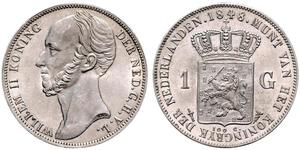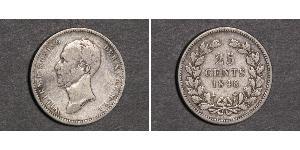| This article needs additional citations for verification. (April 2010) |
| William II | |
|---|---|

William II, by
Jan Baptist van der Hulst, 1849
|
|
| King of the Netherlands; Grand Duke of Luxembourg; Duke of Limburg |
|
| Reign | 7 October 1840 – 17 March 1849 |
| Inauguration | 28 November 1840 |
| Predecessor | William I |
| Successor | William III |
| Spouse | Anna Pavlovna of Russia |
| Issue | William III of the Netherlands Prince Alexander Prince Henry Prince Ernest Casimir Princess Sophie |
| House | House of Orange-Nassau |
| Father | William I of the Netherlands |
| Mother | Wilhelmine of Prussia |
| Born | 6 December 1792 Noordeinde Palace, The Hague, Dutch Republic |
| Died | 17 March 1849 (aged 56) Tilburg, Netherlands |
| Religion | Dutch Reformed Church |
William II (Willem Frederik George Lodewijk, anglicized as William Frederick George Louis; 6 December 1792 – 17 March 1849) was King of the Netherlands, Grand Duke of Luxembourg, and Duke of Limburg.
William II was the son of William I and Wilhelmine of Prussia. When his father proclaimed himself king in 1815, he became Prince of Orange and heir apparent of the Kingdom of the Netherlands. With the abdication of his father on 7 October 1840, William II became king. During his reign, the Netherlands became a parliamentary democracy with the new constitution of 1848.
William II was married to Anna Pavlovna of Russia. They had four sons and one daughter. William II died on 17 March 1849 and was succeeded by his son William III.
Contents
Early life and education[edit]
Willem Frederik George Lodewijk was born on 6 December 1792 in The Hague. He was the eldest son of King William I of the Netherlands and Wilhelmine of Prussia. His maternal grandparents were King Frederick William II of Prussia and his second wife Frederika Louisa of Hesse-Darmstadt.
When William was two, he and his family fled to England after allied British-Hanoverian troops left the Republic and entering French troops joined the anti-orangist Patriots. William spent his youth in Berlin at the Prussian court, where he followed a military education and served in the Prussian army. After this, he studied at the University of Oxford.
William II had a string of relationships with both men and women. The homosexual relationships that William II had as crown prince and as king were reported by journalist Eillert Meeter . The king surrounded himself with male servants whom he could not dismiss because of his 'abominable motive' for hiring them in the first place.[1]
Military service[edit]

He entered the British Army, and in 1811, as aide-de-camp to Arthur Wellesley, 1st Duke of Wellington, took part in several campaigns of the Peninsular War. He was made Lieutenant-Colonel in the British Army on 11 June 1811[2] and Colonel on 21 October that year.[3] On 8 September 1812 he was made an Aide-de-Camp to the Prince Regent[4] and on 14 December 1813 promoted to Major-General.[5] His courage and good nature made him very popular with the British, who nicknamed him "Slender Billy." He returned to the Netherlands in 1813 when his father became sovereign prince.
In 1815, he took service in the Allied army when Napoleon I of France escaped from Elba. He fought as commander of I Allied Corps at the Battle of Quatre Bras (16 June 1815) and the Battle of Waterloo (18 June 1815), where he was wounded.[6] As a sign of gratitude for his victory in Waterloo, William was offered Soestdijk Palace by the Dutch people.[7]
Marriage[edit]
In 1814, William became briefly engaged with Princess Charlotte of Wales, only daughter of the Prince Regent, later George IV of the United Kingdom and his estranged wife Caroline of Brunswick. The engagement was arranged by the Prince Regent, but it was broken because Charlotte's mother was against the marriage and because Charlotte did not want to move to the Netherlands. On 21 February 1816 at the Chapel of the Winter Palace in St. Petersburg, William married Grand Duchess Anna Pavlovna of Russia, youngest sister to Czar Alexander I of Russia, who arranged the marriage to seal the good relations between Imperial Russia and the Netherlands.
On 17 February 1817 in Brussels, his first son Willem Alexander was born, the future King William III. Because he lived in Brussels, he became affiliated with the Southern industrials.
In 1819, he was blackmailed over what Minister of Justice Van Maanen termed in a letter his "shameful and unnatural lusts": presumably bisexuality. He may also have had a relationship with a dandy by the name of Pereira.[8]
Belgian Revolution[edit]
William II enjoyed considerable popularity in what is now Belgium (then the Southern Netherlands), as well as in the Netherlands for his affability and moderation, and in 1830, on the outbreak of the Belgian revolution, he did his utmost in Brussels as a peace broker, to bring about a settlement based on administrative autonomy for the southern provinces, under the House of Orange-Nassau. His father then rejected the terms of accommodation that he had proposed; afterwards, relations with his father were tense.
In April 1831, William II was military leader of the Ten days campaign in Belgium which was driven back to the North by French intervention. European intervention established Leopold of Saxe-Gotha on the new throne of Belgium. Peace was finally established between Belgium and the Netherlands in 1839.
Reign[edit]
On 7 October 1840, on his father's abdication, he acceded to the throne as William II. Although he shared his father's conservative inclinations, he did not intervene in governmental affairs nearly as much as his father had. There was increased agitation for broad constitutional reform and a wider electoral franchise. Although William was certainly no democrat, he acted with sense and moderation.
The Revolutions of 1848 broke out all over Europe. In Paris the Bourbon-Orléans monarchy fell. Fearful that the revolution would spread to Amsterdam next, William decided to institute a more liberal regime, believing it was better to grant reforms instead of having them imposed on him on less favourable terms later. As he later put it, "I changed from conservative to liberal in one night". He chose a committee headed by the prominent liberal Johan Rudolf Thorbecke to create a new constitution. The new document provided that the Eerste Kamer (Senate), previously appointed by the King would be elected indirectly by the Provincial States. The Tweede Kamer (House of Representatives) would be elected directly. The electoral system changed to census suffrage in electoral districts. Most notably, royal power decreased sharply. For all intents and purposes, the king was now a servant of the government rather than its master; the real power passed to the Tweede Kamer. That constitution, significantly amended (most notably with the replacement of census suffrage by universal manhood suffrage and districts with nationwide party-list proportional representation, both in 1917) is still in effect today.
He swore in the first parliamentary cabinet a few months before his sudden death in Tilburg, North Brabant (1849).
He was the 869th Knight of the Order of the Golden Fleece in Spain.
In fiction[edit]
He is a recurring character in the historical novels of Georgette Heyer, most notably in An Infamous Army.
William appears as a character in the historical fiction novel Sharpe's Waterloo by Bernard Cornwell, and its television adaptation, in which he is portrayed by Paul Bettany.
Titles and styles[edit]
- His Serene Highness The Hereditary Prince of Orange (1792–1814)[9]
- His Royal Highness The Hereditary Prince of Orange (1814–1815)[10]
- His Royal Highness The Prince of Orange (1815–1840)
- His Majesty The King of the Netherlands (1840–1849)
Issue[edit]

William II and queen Anna Pavlovna had five children:
- William Alexander Paul Frederick Louis (1817–1890) King of the Netherlands from 1849–1890.
- William Alexander Frederick Constantine Nicolas Michael (1818–1848). Nicknamed Sascha.
- William Frederick Henry "the Navigator" (1820–1879). Married firstly Princess Amalia of Saxe-Weimar-Eisenach and secondly Princess Marie of Prussia, but had no issue.
- Prince William Alexander Ernst Frederick Casimir (21 May – 22 October 1822).
- Wilhelmina Marie Sophie Louise (1824–1897). Married Karl Alexander, Grand Duke of Saxe-Weimar-Eisenach.
Ancestry[edit]
See also[edit]
- Place Guillaume II, a square in Luxembourg City
- Willem II (football club), a Dutch football club
References[edit]
- ^ http://royalehuwelijken.blogspot.nl/2011/12/willem-ii-en-anna-paulowna.html
- ^ The London Gazette: no. 16494. p. 1068. 11 June 1811.
- ^ The London Gazette: no. 16533. p. 2033. 22 October 1811.
- ^ The London Gazette: no. 16642. p. 1812. 8 September 1812.
- ^ The London Gazette: no. 16824. p. 2528. 14 December 1813.
- ^ Hofschröer, Peter, 1815, The Waterloo Campaign, The German Victory p137, p200.
- ^ "Willem II, Koning (1792-1849)". Het Koninklijk Huis (in Dutch). Retrieved 15 December 2014.
- ^ Hermans, Dorine and Hooghiemstra, Daniela: Voor de troon wordt men niet ongestrafd geboren, ooggetuigen van de koningen van Nederland 1830–1890, ISBN 978-90-351-3114-9, 2007.
- ^ "9 December 1813 Het verheugd Rotterdam ontvangt Koning Willem I". Engelfriet.net. Retrieved 2014-05-14.
- ^ "De Grondwet van 1814". Republikanisme.nl. Retrieved 2014-05-14.
External links[edit]
 Media related to William II of the Netherlands at Wikimedia Commons
Media related to William II of the Netherlands at Wikimedia Commons
|
William II of the Netherlands
Born: 6 December 1792 Died: 17 March 1849 |
||
| Regnal titles | ||
|---|---|---|
| Preceded by William I |
King of the Netherlands Grand Duke of Luxembourg Duke of Limburg 1840–1849 |
Succeeded by William III |
| Dutch royalty | ||
| Preceded by William, Prince of Orange later became King William I |
Prince of Orange 1815–1840 |
Succeeded by William, Prince of Orange later became King William III |
| New title | Heir to the Dutch throne as heir apparent 1815–1840 |
|
|
|||||||||||||||||
|
|||||||||||||||||||||||||||||||||||||||||||||||||||||||||||||||||||||||||||||||||||||
|
||||||||
|
||||||||||||||||||||||||||||||
|
||||||||||||||||||||||||||||||||||||||
- 1792 births
- 1849 deaths
- Alumni of the University of Oxford
- British Army commanders of the Napoleonic Wars
- British field marshals
- Burials in the Royal Crypt at Nieuwe Kerk, Delft
- Deaths from pneumonia
- Dukes of Limburg
- Dutch military commanders of the Napoleonic Wars
- Dutch monarchs
- Dutch members of the Dutch Reformed Church
- Dutch princes
- Grand Dukes of Luxembourg
- Grand Masters of the Military William Order
- Grand Masters of the Order of the Netherlands Lion
- Honorary Knights Grand Cross of the Order of the Bath
- House of Orange-Nassau
- Infectious disease deaths in the Netherlands
- Knights Grand Cross of the Military William Order
- Knights Grand Cross of the Royal Guelphic Order
- Knights of the Golden Fleece
- Members of the Council of State (Netherlands)
- People from The Hague
- People of the Belgian Revolution
- Presidents of the Council of State (Netherlands)
- Princes of Orange
- Protestant monarchs
- Prussian Army personnel of the Napoleonic Wars
- Recipients of the Order of St. George of the Second Degree
- Vice Presidents of the Council of State (Netherlands)
















